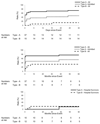Population-based study of incidence and outcome of acute aortic dissection and premorbid risk factor control: 10-year results from the Oxford Vascular Study
- PMID: 23599348
- PMCID: PMC6016737
- DOI: 10.1161/CIRCULATIONAHA.112.000483
Population-based study of incidence and outcome of acute aortic dissection and premorbid risk factor control: 10-year results from the Oxford Vascular Study
Abstract
Background: Acute aortic dissection is a preventable life-threatening condition. However, there have been no prospective population-based studies of incidence or outcome to inform an understanding of risk factors, strategies for prevention, or projections for future clinical service provision.
Methods and results: We prospectively determined incidence and outcomes of all acute aortic dissections in a population of 92 728 in Oxfordshire, United Kingdom, from 2002 to 2012. Among 155 patients with 174 acute aortic events, 54 patients had 59 thoracoabdominal aortic dissections (52 incident events: 6/100 000, 95% confidence interval, 4-7; 37 Stanford type A, 15 Stanford type B; 31 men, mean age=72.0 years). Among patients with type A incident events, 18 (48.6%) died before hospital assessment (61.1% women). The 30-day fatality rate was 47.4% for patients with type A dissections who survived to hospital admission and 13.3% for patients with type B dissections, although subsequent 5-year survival rates were high (85.7% for type A; 83.3% for type B). Even though 67.3% of patients were on antihypertensive drugs, 46.0% of all patients had at least 1 systolic BP ≥180 mm Hg in their primary care records over the preceding 5 years, and the proportion of blood pressures in the hypertensive range (>140/90 mm Hg) averaged 56.0%. Premorbid blood pressure was higher in patients with type A dissections that were immediately fatal than in those who survived to admission (mean/standard deviation pre-event systolic blood pressure=151.2/19.3 versus 137.9/17.9; P<0.001).
Conclusions: Uncontrolled hypertension remains the most significant treatable risk factor for acute aortic dissection. Prospective population-based ascertainment showed that hospital-based registries will underestimate not only incidence and case fatality, but also the association with premorbid hypertension.
Keywords: aortic dissection; blood pressure; morbidity/mortality; population studies; risk factors/global assessment.
Conflict of interest statement
Figures
References
-
- Clouse WD, Hallett JW, Jr, Schaff HV, Spittell PC, Rowland CM, Ilstrup DM, Melton LJ., 3rd Acute aortic dissection: population-based incidence compared with degenerative aortic aneurysm rupture. Mayo Clin Proc. 2004;79:176–80. - PubMed
-
- Mészáros I, Mórocz J, Szlávi J, Schmidt J, Tornóci L, Nagy L, Szép L. Epidemiology and clinicopathology of aortic dissection. Chest. 2000;117:1271–8. - PubMed
-
- Feldman M, Shah M, Elefteriades JA. Medical management of acute type-A aortic dissection. Ann Thorac Cardiovasc Surg. 2009;15:286–93. - PubMed
-
- Subramanian S, Roselli EE. Thoracic aortic dissection: long-term results of endovascular and open repair. Semin Vasc Surg. 2009;22:61–8. - PubMed
Publication types
MeSH terms
Grants and funding
LinkOut - more resources
Full Text Sources
Other Literature Sources
Medical



